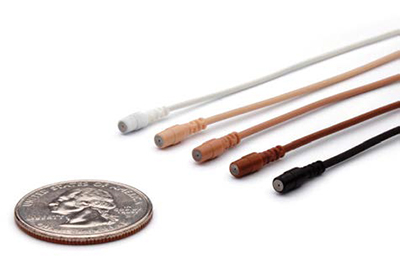
The tiny Countryman B2D is available five colors.
Noisy environments are always a challenge when it comes to picking up good audio. This is particularly true when the noise seems to come from everywhere. Convention floors full of talking people, noisy restaurants, industrial locations with machinery, even TV studios with loud HVAC systems can raise the noise floor. And when that audio gets compressed and limited for broadcasting, the noise isn’t on the floor anymore, it’s unpleasantly up around your armpits.
Live events that require a public address system to amplify voices can also be a challenge. With omni lavalier microphones, you can only turn up the p.a. so far before the mics start picking up p.a. audio, making the sound diffuse and echoey. And if the p.a. gain is increased a little more you’re into feedback.
If you don’t want to go handheld or head/ ear-worn mics, one solution might be the low-profile Countryman B2D hypercardioid lav. At just 2.5mm in diameter (about the size of a No. 2 pencil lead), it’s smaller than many omni lavs. Video producers like that.
FEATURES
The Countryman B2D is available in five different colors; white, black and three shades of light to dark skin tones. It also comes in three sensitivities: B2DW4 (grey band), B2DW5 (red band) and B2DW6 (blue band). The standard B2DW4 is the most sensitive at 6.0 mV/Pascal. The overload sound level is 120 dB SPL. This mic is the choice for most applications.
The mid-sensitivity B2DW5 (red band) sports a lower sensitivity (2.0 mV/Pascal) and an overload sound level point of 130 dB SPL. It’s more useful when worn closer to the face where the voice would be louder. (This could be on a pair of tricked out spectacles or in the hairline of a theatrical performer.)
The B2DW6 (blue band) is the least sensitive (0.6 mV/Pascal) and its overload sound level is 140 dB SPL. It’s probably the way to go if you’re mic-ing opera singers or South American soccer announcers.
The professional video industry's #1 source for news, trends and product and tech information. Sign up below.
All small diaphragm lavs have more self-noise than lavs with larger diaphragms. If you’re in a really quiet environment, you’ll hear this as hiss. However, if your ambient noise is high enough, it will mask the self-noise.
The Countryman microphone people have designed their five-foot mic cables to end with a threaded fitting, and this fitting mates with a large variety of optional connectors: XLR, Hirose 4-pin, Switchcraft TA3F/ TA4F/TA5F, 3.5 mm locking plug, LEMO 3-pin, and the like, allowing it to work with a variety of popular wireless transmitters and other devices.
Connectors may also be ordered that feed just one channel through a 1/8-inch miniature TRS plug.
As these terminations are simple screw on/off, you can use the same mic with different terminations for different setups—hardwired one day or wireless the next.
These cables are thicker and more robust than the Countryman B6 mic cabling, which claims that they can withstand a tug of 45 pounds. They look and feel as if they will last a long time and are also flexible and easy to work with.
As the mic is directional, making sure that it’s placed correctly is absolutely essential. There are three different clips: single mic, double mic and single magnetic backmount. Common to all is a swivel that allows the mic or mics to be properly aimed at the talent’s face after the clip has been secured. Without this feature, the B2D would be difficult to use as it’s possible that the mic may not be aimed properly. All of the B2D mics come with the standard single clip.
These clips also have a small cable hanger that acts as a strain relief and a sound block to dampen vibrations that might attempt to make their way up the cable to the microphone. The mics also have small sections of plastic tubing surrounding the cable that help snug the cable into the hanger without causing wear to the cable itself.
Clips for the dual lav and magnetic single lav units are optional. All of the clips come in five different colors.
In addition to not picking up as much ambient noise and reducing the possibility of feedback, the hypercardioid response pattern results in less spill or bleed from other voices when mic-ing multiple talent. Some consideration, though must be made as to where the unwanted sound is coming from. For example, using a B2D with a noisy HVAC duct directly above the talent will probably not provide the best results, as the mic will hear the talent’s voice and anything else it’s pointed at (in this case, airflow and duct noises).
IN USE
I found that the Countryman B2D performed as expected. I tried it out in a local eatery and it noticeably reduced the din, including the low frequency hum from nearby refrigerators that my omni lav picked up very well. And while I didn’t get the chance to check, I suspect the BD2 mic may reduce desk bounce noise as well.
With the microphone clipped onto a talent’s tie or centered about two buttons on his or her shirtfront, I found the falloff from head turns to be tolerable to about the 60 degree point. When the speaker’s head was turned beyond that (70 to 90 degrees) there was noticably more level falloff, but in fairness you’d certainly experience some fall off from an omni lav as well. I was surprised on one of my tests, however, where I had the mic mounted at tee-shirt collar height, just under the speaker’s chin. In that particular setup, the B2D’s pickup and sound were very good. Maybe I got lucky.
SUMMARY
If noise is the problem, then with an intelligent application, the Countryman B2D can improve your studio or field audio. It’s built tougher than some other lavs that I’ve used and it’s definitely worth a listen.
Ty Ford has been reviewing professional audio gear for over 20 years. Find out more about him atwww.tyford.com.
FAST FACTS
APPLICATION
ENG/EFP
KEY FEATURES
Small, directional, hypercardioid response pattern, available in five colors and three sensitivities
PRICE
MSRP $416
CONTACT
Countryman Associates
800-669-1422
www.countryman.com
